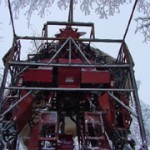Archive for 2004
Rehabilitation Robotics, Orthotics, and Prosthetics
- Тип контента: Научная статья
- Номер документа: 7907
- Название документа: Rehabilitation Robotics, Orthotics, and Prosthetics
- Номер (DOI, IBSN, Патент): Не заполнено
- Изобретатель/автор: KREBS H.I., HOGAN N., DURFEE W., HERR H.
- Правопреемник/учебное заведение: Massachusetts Institute of Technology, University of Minnesota, The Media Lab and The Harvard/MIT Division of Health Science and Technology
- Дата публикации документа: 2004-12-30
- Страна опубликовавшая документ: США
- Язык документа: Английский
- Наименование изделия: Не заполнено
- Источник: Textbook of Neural Repair and Rehabilitation
- Вложения: Да
- Аналитик: Глаголева Елена
 One overarching goal drives our research and development activities: to revolutionize rehabilitation medicine with robotics, mechatronics, and information technologies that can assist movement, enhance treatment and quantify outcomes. In this chapter, we present three fronts of this revolution: rehabilitation robotics, orthotics, and prosthetics. The first and newest approach, rehabilita-tion robotics, has grown significantly in the last ten years (c.f. special issue of the Journal of Rehabilitation Research and Development, 37:6 of Nov/Dec 2000; International Conference on Rehabilitation Robotics – ICORR 2001 and 2003). Previously, robotics were incorporated into assistive devices to help the physically challenged accommodate their impairment. Rehabilitation robotics, by contrast, fashions a new class of interactive and user-friendly robots that enhance the clinicians’ goal of facilitating recovery by not only evaluating but also by delivering measured therapy to patients. Krebs and Hogan review pioneering clinical results in the field, discuss the growing pains of forging a novel technology, and outline the potential for a brilliant future. Of the other two activities, we will limit our discussion to mechatronic systems. Orthotics and prosthetics may be considered as a category of assistive robotics. While the previous high water mark for mechatronic assistive technology occurred during the Vietnam War decades of 1960s and 1970s, recent advancements in materials, computers, and neuro-connectivity (neuro-prostheses) have reinvigorated research in this field. In fact, the lack of equivalent advances in realm of energy storage represents the only major hurdle preventing the realization of practical versions of Hollywood’s fancies such as Star Trek’s Commander Data or the Terminator. Durfee reviews pioneering developments in orthotics, Krebs and Hogan review upper-limb prostheses, and Herr reviews lower extremity prostheses. We will also discuss some emerging developments that could render some science fictions into reality.
One overarching goal drives our research and development activities: to revolutionize rehabilitation medicine with robotics, mechatronics, and information technologies that can assist movement, enhance treatment and quantify outcomes. In this chapter, we present three fronts of this revolution: rehabilitation robotics, orthotics, and prosthetics. The first and newest approach, rehabilita-tion robotics, has grown significantly in the last ten years (c.f. special issue of the Journal of Rehabilitation Research and Development, 37:6 of Nov/Dec 2000; International Conference on Rehabilitation Robotics – ICORR 2001 and 2003). Previously, robotics were incorporated into assistive devices to help the physically challenged accommodate their impairment. Rehabilitation robotics, by contrast, fashions a new class of interactive and user-friendly robots that enhance the clinicians’ goal of facilitating recovery by not only evaluating but also by delivering measured therapy to patients. Krebs and Hogan review pioneering clinical results in the field, discuss the growing pains of forging a novel technology, and outline the potential for a brilliant future. Of the other two activities, we will limit our discussion to mechatronic systems. Orthotics and prosthetics may be considered as a category of assistive robotics. While the previous high water mark for mechatronic assistive technology occurred during the Vietnam War decades of 1960s and 1970s, recent advancements in materials, computers, and neuro-connectivity (neuro-prostheses) have reinvigorated research in this field. In fact, the lack of equivalent advances in realm of energy storage represents the only major hurdle preventing the realization of practical versions of Hollywood’s fancies such as Star Trek’s Commander Data or the Terminator. Durfee reviews pioneering developments in orthotics, Krebs and Hogan review upper-limb prostheses, and Herr reviews lower extremity prostheses. We will also discuss some emerging developments that could render some science fictions into reality.
Категория: Научные статьи | 2 комментария »
Design of Human-Friendly Powered Lower Limb Rehabilitation Orthosis
- Тип контента: Научная статья
- Номер документа: 6044
- Название документа: Design of Human-Friendly Powered Lower Limb Rehabilitation Orthosis
- Номер (DOI, IBSN, Патент): Не заполнено
- Изобретатель/автор: N. Costa, M. Brown, S.Hutchins, D G Caldwell
- Правопреемник/учебное заведение: Directorate for Prosthetics and Orthotics University of Salford Manchester M5 4Wt. UK
- Дата публикации документа: 2004-12-30
- Страна опубликовавшая документ: Великобритания
- Язык документа: Английский
- Наименование изделия: Не заполнено
- Источник: Не заполнено
- Вложения: Да
- Аналитик: Глаголева Елена
 Many patients with spinal injures are confined to wheelchairs, leading to a sedentary lifestyle with secondary pathologies and increased dependence on a carer. Increasing evidence has shown that training using devices such as Reciprocating Gait Orthoses (RGO) reduces the incidence of these secondary pathologies, but the physical effort involved in this training is such that there is poor compliance. This paper reports on the design of a new “human friendly” orthosis powered by high power pneumatic Muscle Actuators. The combination of a highly compliant actuation system with an intelligent embedded control mechanism which senses hip, knee and ankle position, velocity, acceleration and force produces a powerful yet inherently safe operation for paraplegic patients. The application of this technology will greatly improve the rehabilitative protocols for paraplegic patients.
Many patients with spinal injures are confined to wheelchairs, leading to a sedentary lifestyle with secondary pathologies and increased dependence on a carer. Increasing evidence has shown that training using devices such as Reciprocating Gait Orthoses (RGO) reduces the incidence of these secondary pathologies, but the physical effort involved in this training is such that there is poor compliance. This paper reports on the design of a new “human friendly” orthosis powered by high power pneumatic Muscle Actuators. The combination of a highly compliant actuation system with an intelligent embedded control mechanism which senses hip, knee and ankle position, velocity, acceleration and force produces a powerful yet inherently safe operation for paraplegic patients. The application of this technology will greatly improve the rehabilitative protocols for paraplegic patients.
Категория: Научные статьи | 2 комментария »
Сталелитейщик с Аляски строит во дворе NMX04-1A
- Тип контента: Новостная статья
- Номер документа: 2158
- Название документа: Сталелитейщик с Аляски строит во дворе NMX04-1A
- Номер (DOI, IBSN, Патент): Не заполнено
- Изобретатель/автор: Не заполнено
- Правопреемник/учебное заведение: Не заполнено
- Дата публикации документа: 2004-12-23
- Страна опубликовавшая документ: Россия
- Язык документа: Русский
- Наименование изделия: Не заполнено
- Источник: http://www.membrana.ru/particle/2872
- Вложения: Не заполнено
- Аналитик: Ридна Украина)))
 «Эта концепция валялась под ногами очень долго, и я не собираюсь сидеть и ждать, пока какой-нибудь другой парень возьмёт и сделает это, я могу всё сделать сам», — говорит 26-летний американец, готовящийся залезть внутрь гигантского робота и превратить в пюре несколько автомобилей.
«Эта концепция валялась под ногами очень долго, и я не собираюсь сидеть и ждать, пока какой-нибудь другой парень возьмёт и сделает это, я могу всё сделать сам», — говорит 26-летний американец, готовящийся залезть внутрь гигантского робота и превратить в пюре несколько автомобилей.
Категория: Мехи | 1 Комментарий »
Motor rehabilitation using virtual reality
- Тип контента: Научная статья
- Номер документа: 6285
- Название документа: Motor rehabilitation using virtual reality
- Номер (DOI, IBSN, Патент): 10.1186/1743-0003-1-10
- Изобретатель/автор: Heidi Sveistrup
- Правопреемник/учебное заведение: University of Ottawa, Canada
- Дата публикации документа: 2004-12-10
- Страна опубликовавшая документ: Канада
- Язык документа: Английский
- Наименование изделия: Не заполнено
- Источник: Journal of NeuroEngineering and Rehabilitation
- Вложения: Да
- Аналитик: Глаголева Елена
 Virtual Reality (VR) provides a unique medium suited to the achievement of several requirements for effective rehabilitation intervention. Specifically, thera-py can be provided within a functional, purposeful and motivating context. Many VR applications present op-portunities for individuals to participate in experiences, which are engaging and rewarding. In addition to the value of the rehabilitation experience for the user, both therapists and users benefit from the abi-lity to readily grade and document the therapeutic intervention using various systems. In VR, advanced technologies are used to produce simulated, interactive and multi-dimensional environments. Visual inter-faces including desktop monitors and head-mounted displays (HMDs), haptic interfaces, and real-time motion tracking devices are used to create environments allowing users to interact with images and virtual ob-jects in real-time through multiple sensory modalities. Opportunities for object manipulation and body mo-vement through virtual space provide frameworks that, in varying degrees, are perceived as comparable to similar opportunities in the real world. This paper reviews current work on motor rehabilitation using vir-tual environments and virtual reality and where possible, compares outcomes with those achieved in real-world applications.
Virtual Reality (VR) provides a unique medium suited to the achievement of several requirements for effective rehabilitation intervention. Specifically, thera-py can be provided within a functional, purposeful and motivating context. Many VR applications present op-portunities for individuals to participate in experiences, which are engaging and rewarding. In addition to the value of the rehabilitation experience for the user, both therapists and users benefit from the abi-lity to readily grade and document the therapeutic intervention using various systems. In VR, advanced technologies are used to produce simulated, interactive and multi-dimensional environments. Visual inter-faces including desktop monitors and head-mounted displays (HMDs), haptic interfaces, and real-time motion tracking devices are used to create environments allowing users to interact with images and virtual ob-jects in real-time through multiple sensory modalities. Opportunities for object manipulation and body mo-vement through virtual space provide frameworks that, in varying degrees, are perceived as comparable to similar opportunities in the real world. This paper reviews current work on motor rehabilitation using vir-tual environments and virtual reality and where possible, compares outcomes with those achieved in real-world applications.
Категория: Научные статьи | Нет комментариев »
Gravity compensation control system and method using multiple feasibility parameters
- Тип контента: Патент
- Номер документа: 4210
- Название документа: Gravity compensation control system and method using multiple feasibility parameters
- Номер (DOI, IBSN, Патент): US2004/0249319A1
- Изобретатель/автор: Dariush, B.
- Правопреемник/учебное заведение: Не заполнено
- Дата публикации документа: 2004-12-09
- Страна опубликовавшая документ: США
- Язык документа: Английский
- Наименование изделия: Не заполнено
- Источник: http://www.google.com/patents/about/10_824_059_Gravity_compe
- Вложения: Да
- Аналитик: Дмитрий Соловьев
 A method for obtaining an assist torque to be applied to a human joint, in a human assist system in order to reduce load on muscles, according to the present invention comprises the step of obtaining a moment due to gravity, acting on a joint of each human segment, based on equations of force and moment balance on each segment. The method further comprises the step of obtaining an assist torque to be applied to the joint to compensate for the moment due to gravity, acting on the joint. In one embodiment of the present invention, various criteria are used such a mechanical energy, metabolic energy and/or a stability/equilibrium factor. In addition, the present invention can account for the situation when there is substantially no relative motion between segments of a given joint and thus, where the mechanical energy component of gravity compensation is approximately zero.
A method for obtaining an assist torque to be applied to a human joint, in a human assist system in order to reduce load on muscles, according to the present invention comprises the step of obtaining a moment due to gravity, acting on a joint of each human segment, based on equations of force and moment balance on each segment. The method further comprises the step of obtaining an assist torque to be applied to the joint to compensate for the moment due to gravity, acting on the joint. In one embodiment of the present invention, various criteria are used such a mechanical energy, metabolic energy and/or a stability/equilibrium factor. In addition, the present invention can account for the situation when there is substantially no relative motion between segments of a given joint and thus, where the mechanical energy component of gravity compensation is approximately zero.
Категория: Патенты | Нет комментариев »
Статистика
Категорий: 179
Статей всего: 2,003
По типу:
Видео: 36
Выдержка с форума: 1
Контактные данные: 12
Научная статья: 1388
Не заполнено: 5
Новостная статья: 317
Обзор технологии: 42
Патент: 219
Тех.подробности: 34
Тип: 1
Комментариев: 9,473
Изображений: 3,005
Подробней...
ТОР 10 аналитиков
-
Глаголева Елена - 591
Дмитрий Соловьев - 459
Helix - 218
Ридна Украина))) - 85
Наталья Черкасова - 81
max-orduan - 29
Елена Токай - 15
Роман Михайлов - 9
Мансур Жигануров - 4
Дуванова Татьяна - 3
Календарь
| Пн | Вт | Ср | Чт | Пт | Сб | Вс |
|---|---|---|---|---|---|---|
| « Ноя | ||||||
| 1 | 2 | 3 | 4 | |||
| 5 | 6 | 7 | 8 | 9 | 10 | 11 |
| 12 | 13 | 14 | 15 | 16 | 17 | 18 |
| 19 | 20 | 21 | 22 | 23 | 24 | 25 |
| 26 | 27 | 28 | 29 | 30 | 31 | |
Авторизация
Ошибка в тексте?
Выдели её мышкой!
И нажми Ctrl+Enter